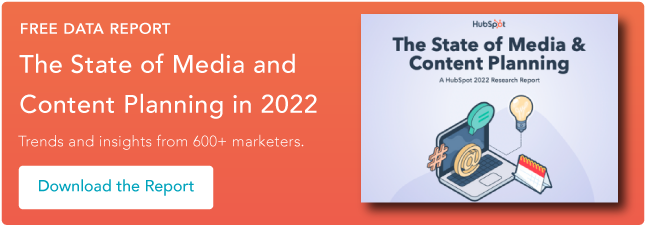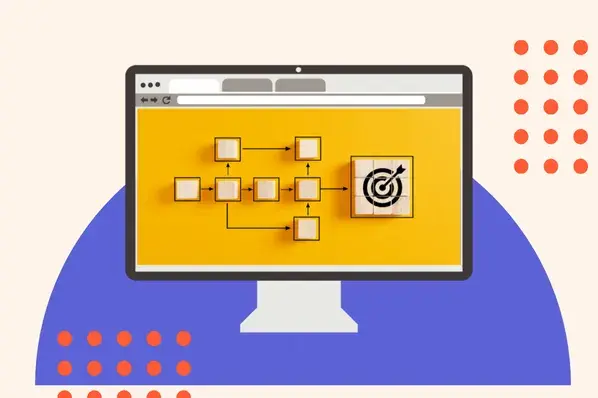We asked HubSpot managers to give their insights about how to navigate major changes that alter your content planning. The HubSpot Blog also surveyed 1,000 marketers to learn more about their content planning practices.
In this post, we'll learn what they have to say. We'll go over how to identify when you need to pivot quickly, and strategies you can take in order to make that transition as smooth as possible.
How to Pivot Your Content Plan
When something major happens to alter your content strategy, think about how it will affect your business goals. After all, the content you're creating reflects the goals of your business.
"The content HubSpot creates is intended to help businesses around the world grow better by addressing their current needs. When we have to pivot our content plans quickly, it is because those needs have changed quickly," says HubSpot's Vice President of Acquisition, Emmy Jonassen.
Let's take a look at advice from Jonassen, as well as tips from managers across the marketing field — including Senior Social Media Manager Kelly Hendrickson, Global Brand Marketing Manager Alicia Collins, and Content Growth Strategy Manager Karla Hesterberg.
Let's get started!
1. Know when to pivot.
Knowing when to switch up your content strategy is never an easy decision to make. There are a couple of aspects you should consider when you find yourself needing to re-work your content strategy, but first is knowing when the right time is to do that.
"The toughest part about pivoting your strategy is knowing when," Hendrickson says. "As a social media manager, I would ask myself, 'Right now, can we provide value to our audience?' 'Can we provide content that will be helpful and welcome in the social space?'"
46% of marketers surveyed by the HubSpot Blog said they knew it was time to pivot because their previous content strategy was experiencing poor engagement.
If you've realized that altering your strategy will help you deliver more valuable, helpful, and timely content to your audience, then it's a good time to pivot.
Ultimately, content plans should serve your business goals, but also deliver worthwhile content to your customer that's timely. If your content isn't providing a timely lens to customers, it might be time for you to pivot your strategy.
A content audit could be a good way to determine if you need a shift. Per the HubSpot Blog survey, 36% of marketers conduct content audits to identify gaps in their content strategy.
Take a look at your content plans. If your information aligns with your business's goals, that's great, but does it align with the times?
Instead of devoting all of your content planning to a new product launch, for instance, change up the frequency of your posts to include more content that can serve your customer's needs depending on what's going on in the industry, or in the world.
2. Put your audience first.
So, you've decided it's a good time to pivot. How do you cater to the new shift in your audience's lives, though?
Check your audience's web behavior — you'll find information that relates to what your audience is thinking about. For instance, if keyword search reports have indicated that keywords are changing from "local marketing tips" to "online marketing tips," think of it as a clue that needs are shifting.
However, this shift isn't exactly what you planned for — in fact, the content you've planned for is already scheduled, ready to go, and ultimately different from the results you've found from researching web behavior.
Hendrickson's team was in the same boat. "In our case, we found we could provide our audience with helpful information," she says. "But that information was not our previously produced and scheduled content."
So, what do you do?
"We paused all publishing and pivoted immediately based on audience needs," says Hendrickson. She and her team saw that they needed to rework how they catered to the needs of their audience with different content, so after some web behavior analysis, they found their answer. "At that time, an immediate need for our audience was tips about remote work and leading with empathy."
She continues by saying, "We made that decision by looking at our audience, as we always do, and figuring out what challenges they were facing and prioritizing our changes there."
 According to a survey conducted by the HubSpot Blog, 46% of marketers have adapted content to reflect the issues going on in their customers' lives.
According to a survey conducted by the HubSpot Blog, 46% of marketers have adapted content to reflect the issues going on in their customers' lives.
When in doubt, start with your audience and put yourself in their shoes. What would you want to see from your favorite brands during certain times of year or periods of change?
If you have a large audience, it's important to make sure your content addresses the needs of different groups you're looking to serve. 38% of marketers surveyed by the HubSpot Blog said their biggest mistake when pivoting their content plan is focusing too much on one segment of their target audience.
As you look to pivot, take a holistic approach to addressing the needs of your broader audience.
3. Change your content lens.
We've talked a lot about how thinking about the customer will help guide your pivot decision and content planning. When you've got an idea of the type of content you need to deliver to your audience, the next step is the delivery itself.
"We need content and campaigns that are helpful and understanding," Collins says. So while your content is framed around helping the audience, does the caption convey an understanding, empathetic point of view?
When you deliver content, you're reflecting your brand and your brand's goals. If one of your brand's goals is to connect with your customer, you must change your message delivery to reflect comprehension of the situation.
Per the HubSpot Blog survey, 43% of marketers have changed the tone of their content to be more empathic and authentic in recent years.
"Companies and customers are operating in different ways — we can't always assume that the same types of marketing will resonate," Collins notes.
 For instance, let's say a major cybersecurity issue upends your industry and is seen everywhere, from LinkedIn posts to newspaper headlines. Rather than shying away from the issue, consider how you might provide content that focuses on IT safety and security, or more generally, tips and tricks for successful online marketing and sales strategies.
For instance, let's say a major cybersecurity issue upends your industry and is seen everywhere, from LinkedIn posts to newspaper headlines. Rather than shying away from the issue, consider how you might provide content that focuses on IT safety and security, or more generally, tips and tricks for successful online marketing and sales strategies.
4. Connect with other colleagues.
"During major industry or global changes, it becomes especially important that we understand our audiences' needs so we can create relevant and helpful content fast," Jonassen remarks.
Recall that Hendrickson's team had to recognize the new needs of their target audiences, and discovered that remote work and how to lead during hard times was increasingly popular. From there, they were able to conduct research and figure out a plan.
However, if you've found that your team is struggling to collect insights, or you don't know how, reach out to other colleagues to come up with a game plan that will be helpful to you. While your customers need actionable, timely, empathetic content, you need to understand how to figure out their other needs, as well.
"We start by analyzing user behavior, talking to our Sales and Customer Service teams, and interviewing prospects and customers," Jonassen says.
 Similar to social media and branding, it's important for team members working on customer acquisition to analyze how their customer will be thinking about their lives differently, so you can create offers that will be relevant to their new lifestyle.
Similar to social media and branding, it's important for team members working on customer acquisition to analyze how their customer will be thinking about their lives differently, so you can create offers that will be relevant to their new lifestyle.
If you find yourself struggling to deduce how your customer thinks because you don't interact with them directly, think about the colleagues you have who do have a customer-facing role.
Sales and Customer Service colleagues are a great place to start — they're in constant contact with customers, and because of that, will have a good grip on recognizing common problem areas among customers.
The best part about this strategy? It fits any business size. Even if your company is a small but mighty one, there's at least one person constantly communicating with customers, and leading hiring efforts. They're your front lines (and usually, talking to them is free, and less time-consuming than conducting multiple research quests).
5. Don't overestimate your pivot.
When you recognize you need to shift, you don't have to launch an entirely new product or completely re-identify your brand. In fact, that's something you shouldn't do.
Hesterberg states, "Don’t change everything at once. The worst thing you can do in a situation like this is pivot too hard and too fast in your rush to meet short-term needs."
It can be startling to customers if a company overhauls their entire strategy overnight (Do you remember the "IHOb" fiasco?), and leave them confused.
My grandmother always used to say, "If it's not broken, don't fix it," a mantra that should apply to your pivot process planning. Changing what your brand stands for can be messy, time-consuming, and confusing for customers.
"Remember that content strategy is always a long game — your short-term strategy can’t compromise your ability to solve for the ongoing, long-term needs of your content property. Find key areas where you can be flexible to meet immediate needs, but know what you can’t budge on," Hesterberg suggests.
 Your pivot should be a balanced addition to the strategy you already have in place. Half of marketers surveyed by the HubSpot Blog said when they last pivoted their content, their content plan changed a moderate amount.
Your pivot should be a balanced addition to the strategy you already have in place. Half of marketers surveyed by the HubSpot Blog said when they last pivoted their content, their content plan changed a moderate amount.
In every campaign you make, one of your goals is most likely to serve the needs of the customer. Keep these tips in mind, and stay calm throughout the storm.
6. Get ready to experiment.
Digital marketing is ever-evolving, and new platforms and features can often be a driving force behind a content pivot. According to the HubSpot Blog survey, 68% of marketers have pivoted their content plan to leverage a new social media platform. We’ve seen this play out in real-time with more brands looking to capitalize on the rise in popularity of TikTok in recent years.
In addition to emerging platforms, jumping on new features of existing platforms can be a key part of a content pivot. Per the HubSpot Blog survey, 77% of marketers have pivoted their content plan to try leveraging a new feature on an existing social media platform, such as Instagram Reels.
Experimentation and flexibility are important for content pivots. When exploring new platforms and features, it can take some time for brands to navigate what their audience wants to see on a new medium.
Content Planning

.jpg)

![How to create an editorial calendar [+ free templates]](https://53.fs1.hubspotusercontent-na1.net/hubfs/53/calendar.png)
![What is an editorial calendar? My guide to building one [examples + templates]](https://53.fs1.hubspotusercontent-na1.net/hubfs/53/editorial-calendar-template-1-20241201-388361.webp)



![How to Write a Creative Brief in 11 Simple Steps [Examples + Templates]](https://53.fs1.hubspotusercontent-na1.net/hubfs/53/creative-brief_2.webp)


.jpg)
